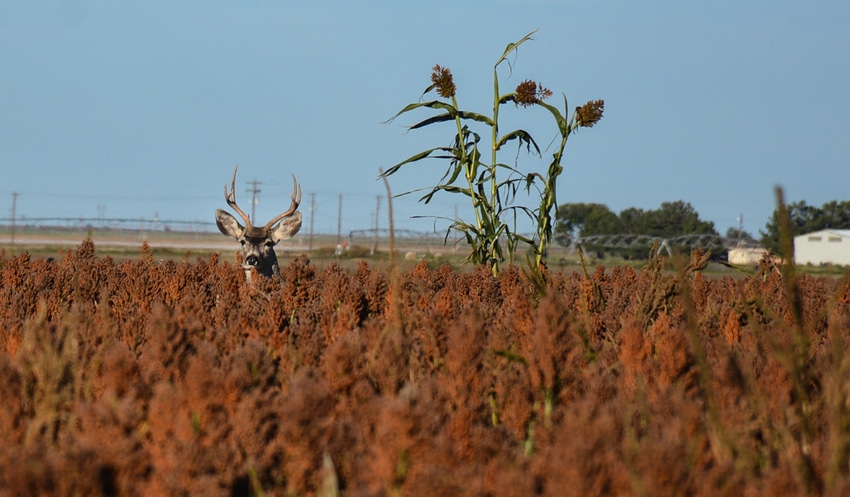February 19, 2019

The Texas Land Trends project of Texas A&M’s Natural Resources Institute, or NRI, has published a special series report describing Texas landowner participation in land conservation easements and their value to agricultural production, water and wildlife.
About 83 percent of lands in Texas are classified as privately-owned working lands, signifying the critical role private landowners play in protecting the state’s valuable resources. Land-use conversion, including fragmentation, accounted for the loss of approximately 1.1 million acres of working lands in Texas between 1997 to 2012.
“A conservation easement is a voluntary agreement between a landowner and a qualified nonprofit land trust or government entity through which the landowner commits to minimize or avoid certain types of non-agricultural development on their property by selling or donating certain property rights,” said NRI director Dr. Roel Lopez.

About 83 percent of lands in Texas are privately-owned working lands.
“Privately owned farms, ranches and forests that produce food and fiber support rural economies and provide wildlife habitat, clean air and water, and recreational opportunities,” he said. “But increasing population growth and development has put extra pressure on working lands, often leading to their fragmentation into smaller parcels or conversion to other land uses, such as residential development.”
FRAGMENTATION
The amount of land fragmentation and conversion is likely to increase over the next decade as lands will likely pass to younger generations who may have less experience, lack financial capital or the motivation and interest needed to sustain family operations, Lopez noted.
According to the Texas Land Trust Council, conservation easements have been an effective tool used by land trusts, government agencies and conservation groups to protect approximately one million acres of private land in Texas. It offers a voluntary, alternative to assist private landowners in keeping their lands intact while promoting good stewardship and land management practices.
Lopez said the institute, in collaboration with the council and Texas Agricultural Land Trust, incorporated several datasets, including those from the Texas Comptroller and U.S. Department of Agriculture’s Census of Agriculture, developed a framework for evaluating the conservation value of lands currently protected under conservation easements. Results of these evaluations can be found online in the Texas Land Trends report “Conservation Easements in Texas,” at http://tinyurl.com/ConservationEasements.
EVALUATION RESULTS
“We were able to assess the value of all conservation easement acres in Texas within three broad categories of ecosystem services — agricultural production, water and wildlife — to illustrate the value of the natural goods, services and benefits conservation easements provide,” Lopez said.
Lopez said Texas has approximately 248,000 farm and ranch operations accounting for over 142 million acres of land use.
“In 2017, these agricultural operations generated about $23 billion in cash receipts and are reported to contribute over $100 billion annually to the food and fiber sector,” he said. “And agricultural employment also plays an important role in the state’s labor force.”
Lopez said using Texas Comptroller land productivity data, which captures the value of the land based solely on its ability to produce commodities, conservation easements in Texas can potentially provide over $63.1 million in agricultural commodities annually.
He said another value of conservation easements to the state is in protecting land-water contributions for current and future water supplies.
“According to the latest Texas State Water Plan, the state will have a nearly 9 million acre-feet water deficit by 2070,” he said. “Conserving undeveloped, permeable working lands can help mitigate both issues by capturing rainfall, reducing water runoff, and increasing groundwater recharge. And by conserving vital floodplains, we can also reduce the risk of flooding.”
Lopez said an NRI study concluded conservation easements are six times more efficient than non-land conservation strategies. In Texas, these have the potential to capture over 980,000 acre-feet of water annually, representing a $1.7 billion water replacement cost savings per year.
WILDLIFE
He noted wildlife also plays an important role in both the state’s economy and ecological well-being, and many landowners are now managing their lands to benefit wildlife.
“Texas Land Trends data shows wildlife management on Texas working lands has increased by over 5.6 million acres since 1997,” Lopez said. “The interest in wildlife is also reflected in the 2016 National Survey of Fishing, Hunting, and Wildlife-Associated Recreation, showing about 104 million Americans are involved in some type of passive or active wildlife-related recreation,”
He said the NRI’s analysis suggests that conservation easements in Texas have the potential to provide approximately $5.8 million in total wildlife value annually.
Lopez said more than 88 percent of conservation easements in the state were executed in the past two decades, indicating an increasing interest and willingness among private landowners to use conservation easements.
“We have also had a positive response from landowners to our surveys related to their land management needs, which also shows us there are opportunities to expand the use of conservation easements in Texas, but the financial incentive to do so isn’t where it needs to be,” he said. “While data support the viability of conservation easements as a tool to conserve land and resources, in Texas funding from state and federal sources to purchase conservation easements has been limited, and this has restricted its use as an effective conservation tool.”
Source: is AgriLife TODAY, which is solely responsible for the information provided and is wholly owned by the source. Informa Business Media and all its subsidiaries are not responsible for any of the content contained in this information asset.
About the Author(s)
You May Also Like




